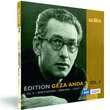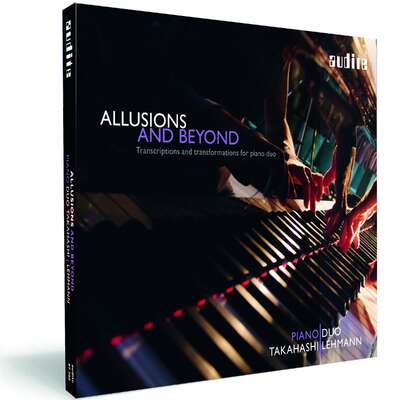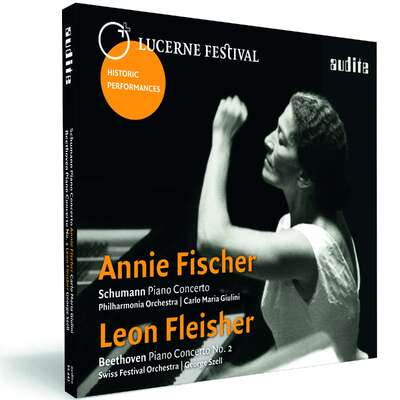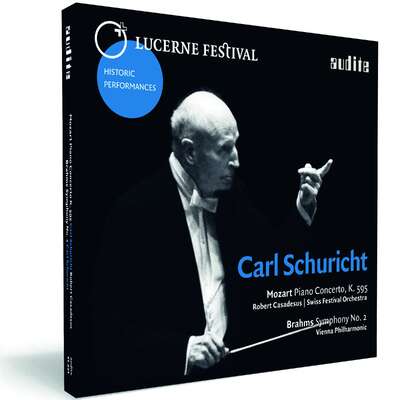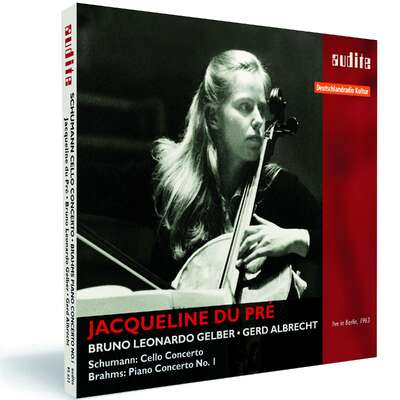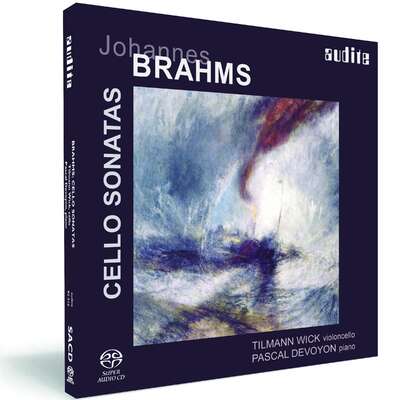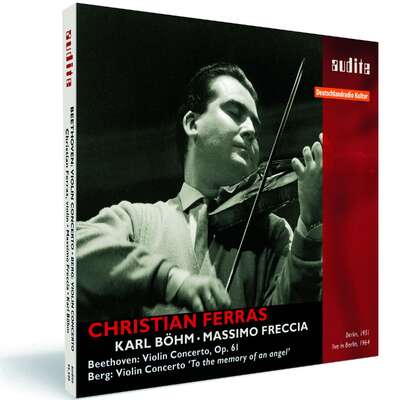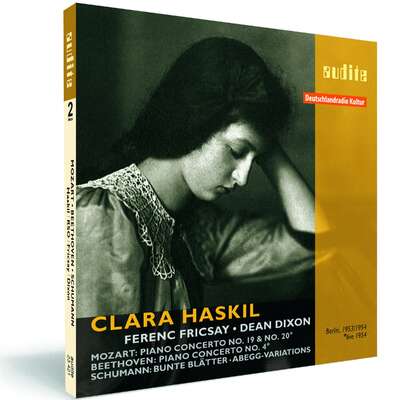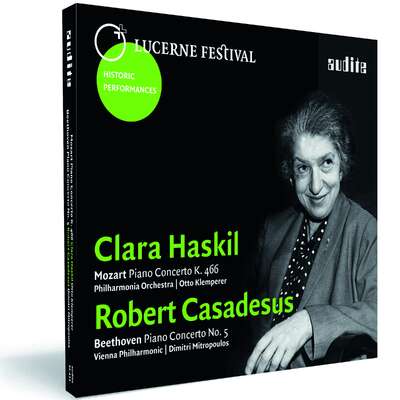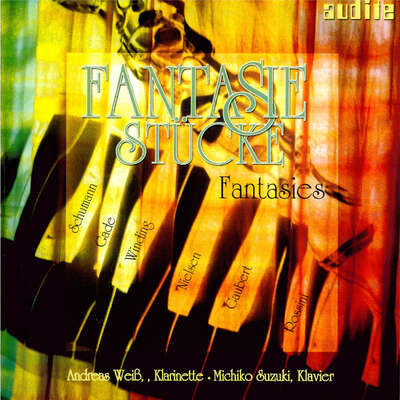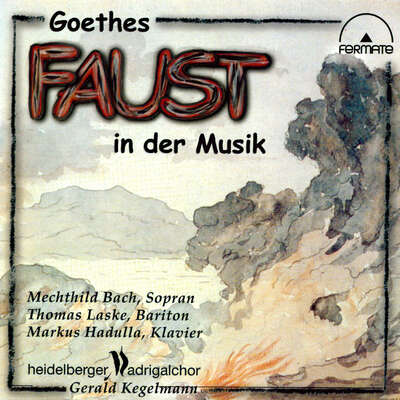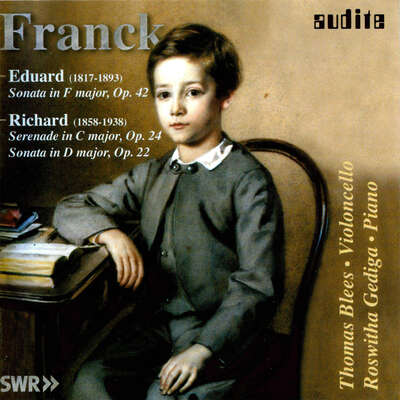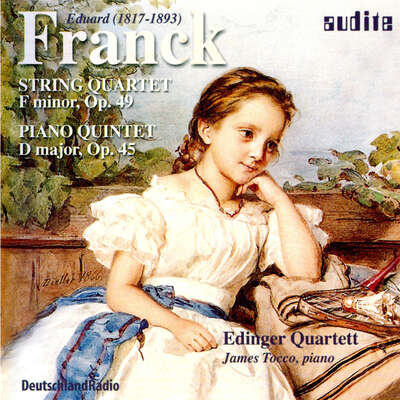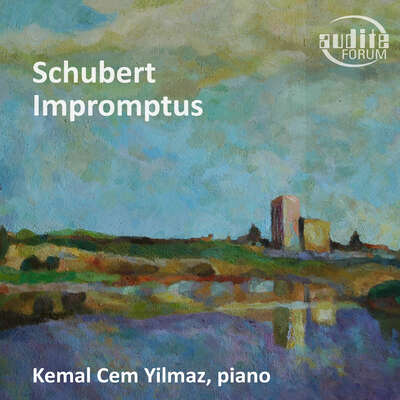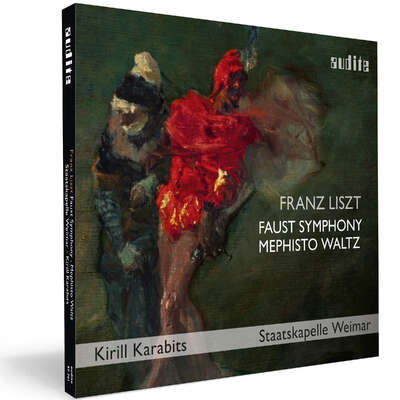
The second volume of recordings by Géza-Anda-Edition from the archives of the WDR Cologne, issued by audite, is dedicated to nineteenth century piano masterpieces which also ranked highly in Anda’s own repertoire. Impressive recordings from 1955 until 1969 can be heard, beginning with his...more
"This is a collection of essential recordings of one of the most outstanding pianists in the fifty and sixty decades of the last century." (critic-service.de)
Track List
Details
| Edition Géza Anda (II) – Beethoven | Brahms | Liszt | |
| article number: | 23.408 |
|---|---|
| EAN barcode: | 4022143234087 |
| price group: | BCA |
| release date: | 20. February 2008 |
| total time: | 147 min. |
Informationen
The second volume of recordings by Géza-Anda-Edition from the archives of the WDR Cologne, issued by audite, is dedicated to nineteenth century piano masterpieces which also ranked highly in Anda’s own repertoire. Impressive recordings from 1955 until 1969 can be heard, beginning with his reading of Beethoven: the strictly non-histrionic but nonetheless poetic interpretation of an early and a late Sonata (Op. 10 No. 3 in D major and Op. 101 in A major) is contrasted by an energetic and intense performance of the Piano Concerto Op. 15 from a live recording (with Anda as soloist as well as conductor). Anda’s significance as a Brahms interpreter is demonstrated by his powerful performance of the early Piano Sonata Op. 5 in F minor and his subtle, melancholy realisation of the three late Intermezzi Op. 117. The high point of this disc, however, is Anda’s technically stupendous and musically superior interpretation of Liszt’s B minor Sonata, whose combination of grandeur and quasi-improvisatory boldness only few pianists are able to execute.
The historical publications at audite are based, without exception, on the original tapes from broadcasting archives. In general these are the original analogue tapes, which attain an astonishingly high quality, even measured by today‘s standards, with their tape speed of up to 76 cm/sec. The remastering – professionally competent and sensitively applied – also uncovers previously hidden details of the interpretations. Thus, a sound of superior quality results. CD publications based on private recordings from broadcasts cannot be compared with these.
Reviews
France Musique | vendredi 16 septembre 2011 | Christophe Bourseiller | September 16, 2011 BROADCAST Musique matin
Sendebeleg siehe PDF!Mehr lesen
Frankfurter Allgemeine Zeitung | 28. Juli 2009, Nr. 172, S. 30 | Eleonore Büning | July 28, 2009
Ein Troubadour des Klavierspiels
Géza Anda ist nicht nur das probate Vorbild bei Mozart und Bartók. Schon vor fünfzig Jahren spielte er Schumann, Liszt, Chopin, Rachmaninow klar und leuchtend
Donnern genügt nicht. Sicher braucht es immer auch die Vehemenz einesMehr lesen
Fanfare | Issue 32:3 (Jan/Feb 2009) | Jerry Dubins | January 1, 2009
The only item in this collection designated as “live” is the Beethoven piano concerto; it also bears the latest recording date. The rest of theMehr lesen
Born in Budapest, Géza Anda (1921–1976) was a pianist I always tended to associate with Bartók, probably because of the Hungarian connection, though his repertoire encompassed a fairly wide range of composers. His highly respected cycle of the complete Mozart concertos with the Salzburg Mozarteum is still available in an eight-disc boxed Deutsche Grammophon set at an incredible bargain price.
For listeners unfamiliar with Anda’s playing and/or those who are newcomers to classical music, the pianist might not be a first choice. His tone, at least on the recordings he made during the late 1950s and throughout the 1960s, can come across as sounding a bit brittle and steely. Assiduous in matters of technical precision, his playing can also at times seem to be disengaged and lacking in expression. Yet it was precisely Anda’s steeliness of touch and precision of execution that I found so compelling in his Bartók; and his refusal to bedeck Mozart in floral wreaths was refreshing.
Yet virtue in one composer is not necessarily so in another. Anda’s rendition of Beethoven’s C-Major Piano Concerto in this collection sounds literal and aloof. Moreover, what was at the time the Cologne Radio Symphony Orchestra—today the much-improved WDR Symphony Orchestra of Cologne—was no Berlin Philharmonic. The playing is plagued throughout by poor intonation, mainly, and unexpectedly, in the strings rather than in the winds.
Anda’s performance of Beethoven’s Piano Sonata No. 7 in D is mechanically exact, but essentially dry and humorless. By the time he gets to the late A-Major Sonata No. 28, Anda intuits that he is in a different musical universe, but it is one that makes expressive demands on him he can’t quite seem to relate to. The result is a very strange interpretation characterized by halting phrasing and ritards and diminuendos that seem to run off the shoulder of the road and into a ditch. Also, uncharacteristically for Anda, there is a very noticeable flub at 3: 18 in the second movement.
The Brahms sonata that begins disc 2 marks an improvement in Anda’s playing, though not, unfortunately, in the recorded sound. The sheer bigness of the work—its dynamic and tonal range—swamps the acoustic setting and stresses the recording technology. The highest notes are flattened out and glassy sounding, while the loudest passages must have needed to be compressed in order to avoid breakup. It’s too bad, because it’s in the Brahms Third Sonata that Anda really shines in a reading that reminds me of Richter’s way with the composer, though Richter, for some reason it appears, never recorded the Third Sonata, only the First and Second.
As in the late Beethoven Sonata, Anda is once again a bit adrift in Brahms’s late op. 117 reflective musings. Like someone who senses there is something just beyond his grasp that he desperately wishes to penetrate but can’t, Anda projects onto these pieces a mode of expression that is not natural to them. The result sounds awkward and arch.
As with the Brahms Sonata, Anda is back in his element with Liszt. This is a B-Minor Sonata that goes head to head with some of the best—Richter, Horowitz, and Cziffra, to name just three electrifying versions. One must wait until the end of this two-disc set to get to the red meat of this collection, but the wait is worth it; or, you can just go directly to track 9 on disc 2, and be flabbergasted. For the Liszt alone—and secondarily for the Brahms Sonata, though the sound is poor—I would recommend this set. But if those two works are not of particular interest to you, I’d reserve recommendation mainly for Anda devotees.
Neue Musikzeitung | 12/08 - 57. Jahrgang | Hanspeter Krellmann | December 1, 2008
Von der poetischen Auflösung der Musik
Géza Anda beim WDR Köln: zur neuen Gesamt-Edition bei audite
Er [Geza Anda] verfügte geradezu beneidenswert über die Begabung, Musik jeder Ausrichtung poetisch aufzulösen und ihr auf diese Weise eine nach innen wirkende Sensation zu sichern.Mehr lesen
American Record Guide | December 2008 | Becker | December 1, 2008
This is the second volume of the Geza Anda Edition (a review of Volume 1 will appear in a forthcoming issue). In all, Audite will issue four volumes,Mehr lesen
Anda left a fairly large recorded legacy. Recorded from 1955 to 1969, the sound is reasonably good to excellent. None is identified as stereo, though the Beethoven concerto from 1969 certainly is. There is no indication of an audience, though it is the only work labeled "live". The analog recording is clear, clean, and well balanced. Anda, conductor and pianist, gives a strong performance and, while the Cologne forces are not those of Berlin, I like the reedy quality of the winds.
Energy and even temperament are the hallmarks of his Beethoven sonata interpretations. He keeps things moving along without sacrificing little niceties along the way. The 1957 recording of his Brahms sonata is pushed to its limit to cope with his forward sound. The Intermezzos, recorded in 1960, present no such problem – the microphone is no longer looking down the throat of the piano. These are enjoyable, but coming on the heels of Marcus Groh's fabulous Op. 117 in this issue, made them less impressive.
Liszt's magnificent sonata, here in just one track, is perhaps the high point of this set. Dating from 1955, just a year after his commercial recording for Columbia, it is an even stronger performance. The sound is distortion free and with plenty of depth. It certainly would have to rank among the best recorded performances of all time.
klassik.com | November 2008 | Dr. Daniel Krause | November 14, 2008 | source: http://magazin.k... Vier Mal Meisterschaft
Audite bringt im Verbund mit dem Westdeutschen Rundfunk Géza Andas KölnerMehr lesen
Die Presse | 20.10.2008 | Schaufenster | Wilhelm Sinkovicz | October 20, 2008 Mozart erlesen, Bartók kongenial
Als Bartók-Interpret ist er eine Legende, als feinsinniger MozartspielerMehr lesen
Fono Forum | September 2008 | Ingo Harden | September 1, 2008 Von Paderewski bis Gulda
Immer mehr alte Klavieraufzeichnungen auf Schellack, Klavierrollen und Rundfunkbändern finden den Weg in die CD-Kataloge. Eine Revue der wichtigstenMehr lesen
Um mit einer angreifbaren, aber empirisch bewährten Hypothese zu beginnen: Wer mit Lust und Freude Platten sammelt, den wird es früher oder später auch zu „historischen“ Aufzeichnungen ziehen: weil die Beschäftigung mit neuen Aufnahmen über kurz oder lang neugierig macht auf das, was vorher war. Und weil Emil Berliners und Edwin Weites Erfindungen die Möglichkeit eröffnet haben, sich jetzt immerhin schon in die akustische Vergangenheit eines ganzen Jahrhunderts zurückzutasten.
Allerdings muss der Hörer beim Abhören alter Aufnahmen kompensieren können. Denn erstens bewahren besonders die frühen Schellacks wegen ihres begrenzten Klangspektrums und Pegels nur ein farbschwaches Abbild der tönenden Realität. Und zweitens waren die musikalischen Vorstellungen unserer Altvorderen noch stark vom ganzheitlichen Eindruck jeder Aufführung bestimmt. Vom akustischen Erscheinungsbild erwartete man offenbar bis in die 1940er Jahre noch nicht zwingend Perfektion nach heutigen Vorstellungen; frühere Konzertbesucher waren besser darauf eingerichtet, sich Fehlendes und Intendiertes ergänzend aus den optischen Signalen des Interpreten zu erschließen.
[…]
Sonderstatus besitzt dagegen die Berliner Aufnahme des c-Moll-Konzerts mit dem 75-jährigen Wilhelm Kempff: vorhersehbar gänzlich unheroisch, aber immer luzide geistreich und spontan. Und was für ein guter Dirigent war Maazel, als er noch nicht so deutlich zeigte, dass er sich dessen allzu sehr bewusst war!
Die Audite-Musikproduktion Ludger Böckenhoffs, dem diese Erschließung zu danken ist, stellt gleichzeitig eine ausführliche „Edition Géza Anda“ vor, die auf acht CDs Aufnahmen aus dem WDR-Archiv, vorwiegend aus den 1950er Jahren, publik macht. Sie ist wertvoll vor allem durch die Interpretationen der großen Romantiker-Werke, die der Dreißiger Anda fabelhaft „werktreu“ konzentriert und mit hervorragendem (und hervorragend eingefangenem!) Ton spielte. Die Edition ist das überfällige Gegengewicht zur Mozart-Serie der DG, die das gängige Anda-Bild bisher einseitig einfärbte.
CD Compact | Septiembre 2008 | Verónica Maynés | September 1, 2008 Audite Edition Géza Anda
Si el lector es uno de esos melómanos sibaríticos y exigentes, que estáMehr lesen
BBC Music Magazine | September 2008 | Michael Tanner | September 1, 2008
Listening to Géza Anda, playing such a widely contrasting range of composers (including Mozart in the May issue and Bartók in August), has been aMehr lesen
The Beethoven Concerto, numbered as '1' but second in order of composition, is conducted by Anda, and the orchestra proves highly responsive. This radiant and exhilarating work gets as lively a performance as it deserves, and could easily be a first choice for anyone who isn't addicted to state-of-the-art sound. It's followed by a straightforward rendition of Beethoven's first large-scale piano sonata, which Anda is careful not to over-dramatise; and then he plays the elusive, ground-breaking Op. 101, which, thanks to its seemingly improvisatory character, gets mauled by many pianists. Anda plays it spontaneously, but without searching for effect.
The directness of his playing is one of its most attractive features, and is as rewarding in Chopin and Schumann as in classical repertoire. The extraordinary freshness of both these composers, in their approach to form, signalled by the capricious titles that Schumann often gave his works, and the very general ones which Chopin awarded his, comes across quite marvellously in all these performances. Anda wasn't an exploiter of extremes, so if you want the unbridled fury of the last of Chopin's Op. 28 Preludes go to Argerich; or to Richter to unleash a volcano in the penultimate Etude Op. 25. But listened to as whole sets, Anda offers unfailing insights, gives new life to numbers that can sound tired, and left me purring with satisfaction at such lack of ostentation. Anyone who thinks Romantic music has to be played with flamboyance should listen to the Liszt and Brahms here and will soon develop quite different priorities.
Gramophone | August 2008 | Bryce Morrison | August 1, 2008 Even if the Beethoven doesn't stand out there's plenty of Anda's artistry here
These recordings dating from 1955-69 and taken from the West German Radio Archives celebrate the artistry of Géza Anda whose tragic death at the ageMehr lesen
True, virtually all the works included here on Vols 2 and 3 are duplicated on Testament's nine-CD reissue of Anda's early EMI Londonbased recordings. But duplication is hardly the issue because although Anda had a clear ground-plan for his interpretations, they could fluctuate with subtle differences dictated by circumstances and the mood of the moment. Nothing is radically different yet side-by-side comparison tells us that Anda was essentially a recreative artist who altered his readings as some new diamond-like facet of a work caught his imagination. True, his Beethoven remains for all its quality more reasonable than revolutionary (though quite without the disfiguring quirks of, say, Gould, Mustonen or Pletnev). Yet if his playing becomes brilliantly alive in the finales of both sonatas, he finds his truest voice in Chopin, Brahms, Liszt and, most of all, Schumann. Here he is every inch the virtuoso who uses his phenomenal agility and ear for sonority and texture to such effect that everything emerges in its first pristine light.
Personal idiosyncrasies abound (why such a rapid spin through the central lento of Chopin's "octave" Etude; why such an uncharacteristically flustered way with the E major Prelude's ceremonial tread?) yet they remain like spots on the sun. Few more scintillating or tightly coiled Liszt Sonatas exist and who but Anda could capture Schumann's schizophrenic moodswings, his play of light and shade, so vividly or acutely? Try the third and ninth etudes from the Etudes symphoniques and you may well wonder when you have heard such light-fingered enchantment. Anda's way with two of the five additional posthumous etudes is so magical that you wish he had played them all. His inclusion, too, of "Sphinxes" in Carnaval (written in order not to be played!) is an amusing addition to his coruscating wit and elegance.
Audite's recordings have come up well and, hopefully, Anda's discs of Beethoven's Third Concerto, Franck's Symphonic Variations (among his own favourites), Chopin's Second Sonata and Ravel's Valses nobles et sentimentales will become more easily available.
Arte | 8. Juli 2008 | Mathias Heizmann | July 8, 2008 Géza Anda
Eine Handvoll CDs, ein CD-Player, ein paar Liter Benzin, und es kannMehr lesen
Diapason | juillet-août 2008 | Etienne Moreau | July 1, 2008
Les archives des studios de la Radio de Cologne et de son orchestre (aujourd'hui WDR Sinfonieorchester Köln) n'ont pas fini de nous livrer leursMehr lesen
Le volume suivant comporte un Concerto n° 1 de Beethoven en public, volontaire et lumineux, et surtout deux sonates qui font regretter que Geza Anda n'ait pas persisté dans la voie du Maître de Bonn, tant le résultat est convaincant par sa clarté et sa finesse. La sonate de Liszt et la Sonate n° 3 de Brahms sont l'occasion de montrer quel grand pianiste il fut, attiré par la lumière des aigus comme dans des Intermezzi d'un Brahms chauffant ses vieux os au soleil, ici magnifiquement et sobrement restitués.
Les Schumann (Vol. III) sonnent juste, comme chaque fois avec Anda, même si on peut leur préférer les enregistrements commerciaux, plus aboutis, publiés chez Deutsche Grammophon quelques années plus tard – Carnaval excepté. Les Préludes de Chopin sont d'un classicisme et les Etudes d'une épure – une seule et même grande arche – qui en disent long sur l'intelligence du style et sur les capacités intellectuelles et instrumentales du personnage.
Le dernier volume, consacré à Bartok, montre Geza Anda dans son élément, qu'il s'agisse des concertos, fins et aériens (particulièrement le deuxième avec Fricsay), ou dans la Suite op. 14 aux harmonies vif-argent, comme improvisée avec ses allures de folklore inventé. La Sonate pour deux pianos et percussions en compagnie de Solti est passionnante tandis que les Contrastes revendiquent leur modernité avec une clairvoyance qui achève de convaincre, s'il était besoin, de l'immensité du talent d'un artiste disparu bien trop tôt.
Scherzo | Julio 2008 | Rafael Ortega Basagoiti | July 1, 2008
De Pianistas: Géza Anda
Audite (distribuidor Diverdi) edita una colección en cuatro volúmenes, cada uno con dos discos, dedicada al pianista húngaro Géza Anda.
El volumen 1 (Audite 23.407) contiene obras de Mozart (Conciertos n°sMehr lesen
Crescendo Magazine | N° 94 - Été 2008 | Bernard Postiau | July 1, 2008 Une édition Geza Anda chez Audite
On ne louera pas assez l'éditeur Audite de consacrer une série de huitMehr lesen
Audiophile Audition | June 2008 | Gary Lemco | June 16, 2008
The second of a four-volume collection from WDR archives celebrating “theMehr lesen
Pizzicato | Juni 2008 | Alain Steffen | June 1, 2008 Unschätzbare Anda-Sammlung
Da es nicht sonderlich viele Aufnahmen des genialen ungarischen Pianisten Géza Anda gibt, besitzt diese Hommage für den Sammler einen unschätzbarenMehr lesen
Auch bei Chopin findet der Pianist die musikalische Wahrheit hinter der Virtuosität und beweist, dass die 24 Préludes bzw. die 12 Etudes des polnischen Meisters alles andere als Salonstücke sind. Diskutabler dagegen scheint mir Andas Annäherung an Schumann. Anstelle von Fantasie setzt Anda größtmöglichen Ernst, was allerdings Stücke wie Kreisleriana, Symphonische Etuden oder Carnaval nicht immer ins optimale Licht rückt. Somit bleiben die Schumann-Werke in der Aussage etwas akademisch, wenn Anda spieltechnisch auch hier wieder eine Meisterleistung bietet.
Die vierte Doppel-CD ist Werken von Bela Bartok gewidmet und ist die vielleicht aufregendste Publikation der Serie. Anda spielt hier die beiden Klavierkonzerte, Nr. 1 unter der Leitung von Michael Gielen, Nr. 2 unter Ferenc Fricsay, mit dem er ja einige Jahre später alle drei Konzerte für Deutsche Grammophon aufgenommen hat. Andas frische und direkte Annäherung dieser früheren Aufnahmen zeigt den Pianisten weniger auf der Suche nach Wahrheiten als in der Auseinandersetzung mit Klang und Struktur. Somit wirken beide Konzerte zugänglicher, zumal sowohl der junge Gielen wie auch Fricsay mit der gleichen Stringenz vorgehen wie der Solist. Georg Solti ist Andas Partner in der Sonate für zwei Klaviere und Schlagzeug, ein rares historisches Dokument und darüber hinaus in einer dynamischen und vollblutigen Interpretation. Sehr schön auch die Klaviersuite op. 14, die Anda als einen genuinen Bartok-Interpreten ausweist, sowie die weniger bekannten 'Kontraste für Klarinette, Violine und Klavier' mit u.a. dem hervorragenden Tibor Varga.
Musica | musica 197, giugno 2008 | Riccardo Risaliti | June 1, 2008
Il tempo che passa inesorabile livella e oscura, indebolendo i ricordi. ChiMehr lesen
Classica-Répertoire | juin 2008 | Jacques Bonnaure | June 1, 2008
Ce que l'on entend dans le volume II de la série WDR consacrée à GézaMehr lesen
www.classicstodayfrance.com | Juin 2008 | Christophe Huss | June 1, 2008
Ce volume 2 de l'édition Géza Anda nous donne l'occasion de nous rappelerMehr lesen
www.critic-service.de | 35 | Christian Ekowski | May 7, 2008
Die Dokumentation mit Einspielungen des Pianisten Géza Anda war notwendig.Mehr lesen
Piano News | 3/2008 - Mai/Juni | Carsten Dürer | May 1, 2008
Gleich zwei Reihen von CDs mit Aufnahmen des legendären ungarischenMehr lesen
NDR Kultur | CD-Neuheiten | 20.04.2008 19:20 Uhr | Philipp Cavert | April 20, 2008 Geza Anda: magisch und ruhig
Wie im vorangegangenen Beispiel Piotr Anderszewski, ist auch Geza Anda hier dirigierender Klaviersolist. Er spielt mit magischer Gelassenheit und eineMehr lesen
Diverdi Magazin | N° 168 / marzo 2008 | Pablo-L. Rodríguez | March 1, 2008
El camaleón del piano
Audite lanza una impresionante colección In dedicada al eximio pianista húngaro-suizo Géza Anda
Géza Anda (1921-1976) llegó a hacer planes para dirigir una Tosca de Puccini poco antes de su muerte. ¿Sorprendente? Pues no, porque Anda, ademásMehr lesen
En realidad, existe tan sólo una monografía sobre este gran pianista suizo de origen húngaro que fue publicada por Hans-Christian Schmidt en 1991 bajo el curioso y objetivo título de Geza Anda: Sechzehntel Sind Auch Musik! Dokumente Seines Lebens (Zúrich: Artemis & Winkler). Se trata de una recopilación de comentarios y documentos encaminada a profundizar en la filosofía interpretativa de Anda que nació bajo el auspicio del concurso pianístico trienal que lleva su nombre en la capital suiza. En ella encontramos muchas claves para entender el arte de Anda (o "su espíritu", como lo denomina Schmidt) que parten de la idea de que su concepción de la música iba más allá de los problemas técnicos de su instrumento o de las limitaciones de un repertorio concreto. De hecho, el fin último de su interpretación pretende alcanzar el nivel dialéctico para presentar un texto objetivo por medios subjetivos, y ello es lo que le permite alcanzar un perfecto dualismo (imposible para otros pianistas) entre la pasión y robustez propias de Florestán y el intimismo lírico de Eusebius en sus interpretaciones de Schumann o le ayuda a encontrar la claridad necesaria para Mozart como resultado de un acercamiento muy profundo e intelectual a este compositor, o incluso lograr el equilibrio necesario en Bartók al atender no sólo a lo escrito en sus partituras como compositor sino también a las particularidades de él como pianista.
Y es que para Anda tocar el piano era una forma de intelectualidad y de reflexión filosófica. A diferencia de otros pianistas, él no fue un niño prodigio y quizá ello le permitió concentrarse más en el enriquecimiento de su personalidad artística que en el mero fortalecimiento de sus dedos. En esto último encontraría apoyo tanto en su maestro, Ernö von Dohnanyi, como también en varios colegas mayores como Clara Haskil, Alfred Cortot o Edwin Fischer, o incluso también en el filósofo Pierre Souvchinsky. Desde luego, la principal faceta de su arte reside en la capacidad innata que alcanzó Anda para adaptar su interpretación al estilo de cada compositor, pues prácticamente nunca uno encuentra en un mismo pianista acercamientos tan válidos y profundos a compositores y estilos tan diversos.
Ciertamente, la discografía de Géza Anda ha aumentado bastante en los últimos años. Lanzamientos de Testament, Hunt, Orfeo, BBC Music, Tahra, Idis, Col legno, Archipel o Golden Melodram han engrosado la lista de sus registros fonográficos a partir de archivos radiofónicos, que se suman a sus registros oficiales para EMI, DGG y RCA disponibles hoy en su gran mayoría. Sin embargo, muy pocos sellos han reparado en lo conservado de Anda en las corporaciones radiofónicas de la antigua República Federal alemana (la NDR, WDR, SWR, SR, BR, HR y la RIAS berlinesa) o, por lo menos, desde la frustrada edición en LP dedicada a este pianista por Ariola-Eurodisc en los setenta. Audite nos redescubre la figura de Géza Anda centrándose tan sólo en uno de estos archivos, el de la Westdeutscher Rundfunk de Colonia (WDR), y publicando en cuatro entregas de dos discos un total de veintidós obras concertantes, solistas y camerísticas de Mozart, Beethoven, Brahms, Liszt, Schumann, Chopin y Bartók en su mayoría muy representativas del arte de Anda. Todos son registros inéditos en CD, realizados entre 1952 y 1969, cuya calidad va de lo aceptable a lo excelente, debido al buen estado de las cintas conservadas, a los nombres de los responsables técnicos de las mismas (en especial a Hans-Georg Daehn y a Heinz Oepen) y también a la labor de remasterización de Stephan Schmidt.
El primer volumen se dedica a Mozarr y en él encontramos cuatro conciertos muy característicos del repertorio de Anda junto a la rareza de una sinfonía interpretada bajo su dirección. En el Concierto n° 23 y la Sinfonía n° 28, Anda dirige a la Camerata Academica de Salzburgo, una formación con la que dio el salto de tocar dirigiendo en 1960, consiguiendo materializar con ellos su Mozart elegante, cantable y encantador (aderezado aquí con cadencias propias) y con la que grabó la pionera integral concertante para piano del salzburgués en los sesenta para DGG (siguiendo el ejemplo y la influencia de Edwin Fischer). No obstante, además de sus interpretaciones dirigiendo (se incluye además otra del Concierto n° 20 con la orquesta de la radio) sus colaboraciones con otros directores también fueron fructíferas, como queda patente en el mágico Andante del Concierto n° 21 dirigido por un inspiradísimo Joseph Keilberth en 1956.
El segundo volumen se consagra a Beethoven, Brahms y Liszt. Para empezar, Anda no fue un pianista especialmente beethoveniano, pues tan sólo tocó y grabó cinco sonatas y cuatro de sus conciertos (además de las Variaciones Diabelli y el Triple Concierto), aunque ello no quiere decir que su Beethoven sea menos interesante. Sin duda, entre lo más destacado de este volumen se encuentra su vienesa interpretación de su Primer concierto pianístico, tocando y dirígiendo en 1969, junto a una de las versiones más concentradas, bellas y misteriosas del Largo e mesto de Sonata n° 7, registrada en 1955. Las grabaciones intimistas de Brahms se suman a las realizadas en los cincuenta para EMI (Testament) y la gran sorpresa la encontramos en la Sonata de Liszt de 1955, que deja a un lado su registro del año anterior (Testament) y ahonda en lo narrativo, exquisito y dramático de esta música.
El tercer volumen incluye Otras dos especialidades de Anda: Schumann y Chopin. Sus versiones del primero son hoy todavía muy admiradas, especialmente por lo que tienen de mixtura entre la austeridad y objetividad clásica y la sensación de fluir continuo, de libertad, en una palabra. Al mismo tiempo, en sus interpretaciones destaca un transfondo muy polifónico y contrapuntístico, que supone llegar a Schumann y a Chopin desde Bach. En cierto modo, si en la idea de tocar y dirigir Mozart hay una clara influencia de Fischer, aquí encontramos la huella de Cortot (en todos ellos estaría también la de Haskil). Ninguna de las versiones de la Kreisleriana, los Estudios sinfónicos o el Carnaval, o de los Estudios y Preludios de Chopin, tienen nada que envidiar a sus famosos registros de los cincuenta (Testament) o los sesenta (DGG), y aquí Anda es el verdadero paradigma de un artista universal que "da cuenta de la música por sí misma", como dijo de él el filósofo Gabriel Marcel.
Finalmente, el cuarto volumen se dedica al compositor donde las interpretaciones de Anda siguen siendo más influyentes: Bela Bartók. Hoy nadie duda de que Géza Anda fue quien introdujo en el repertorio los tres conciertos pianísticos de Bartók, que tocó cientos de veces (incluso los tres en la misma velada como atestigua el impresionante concierto muniqués de 1957 publicado por Col legno) y grabó brillantemente junto a Ferenc Fricsay entre 1960 y 1961 (DGG). Pues bien, en este disco Audite publica el primer encuentro entre ambos artistas, que tuvo lugar en Salzburgo en 1952 y que se saldó con la versión más rapsódica, fresca y neoclásica del Concierto n° 2 del compositor húngaro (en los archivos de la WDR hay otro registro posterior de ambos). El resto no desmerece lo histórico de este registro, especialmente al incluir dos sorprendentes tomas camerísticos de Anda de Contrastes y de la Sonata para dos pianos y percursión realizados en 1953 en colaboración con viejos compañeros de estudios y amigos de su Hungría natal como Tibor Varga y Georg Solti. Y es que, según parece, hasta 1976 – el año de su muerte – Anda no descubrió su vocación tardía por la música de cámara, tocando en Innsbruck el Quinteto "La Trucha" de Schubert. Si a esto sumamos sus proyectos como director de orquesta está claro que su prematura muerte nos privó de Anda para rato.
